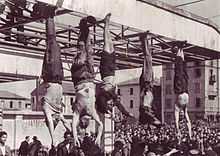Alessandro Pavolini

Alessandro Pavolini (27 September 1903 – 28 April 1945) was an Italian politician, journalist, and essayist, notable for his involvement in the Fascist government during World War II and also for his cruelty against the opponents of fascism.
Early life and career
A native of Florence, Pavolini was the son of Paolo Emilio Pavolini, a major scholar of Sanskrit and other Indo-European languages. A brilliant student, he earned a law degree at the University of Florence and a political science degree at La Sapienza in Rome, travelling to and fro between the two cities.
After joining Benito Mussolini's movement in Florence, he took part in several actions of the Blackshirts, and led a squad during the 1922 March on Rome - the moment when Fascism took over in Italy. Pavolini was assigned tasks in the cultural field (including youth programs launched by the fascists), while contributing to fascist publications such as Battaglie fasciste, Rivoluzione fascista, and Critica fascista. Thanks to his acquaintance with Florentine fascist leader Luigi Ridolfi, he broke into active politics, becoming Ridolfi's deputy in 1927. From 1929 to 1934, he was local leader of the National Fascist Party (PNF) in Florence, as well as editor of the fascist publication Bargello (named after a military rank of the Middle Ages), which urged all intellectuals to contribute; Pavolini aimed for an image of Fascism as cultural and aristocratic - he initiated a series of cultural events that survived both Fascism and his death, including the yearly costumed re-enactment of the Italian Renaissance-era sport Calcio Fiorentino, the Maggio Musicale Fiorentino and the Ponte Vecchio Artisans' Exhibit. Between 1934 and 1942, he was a regular contributor to Corriere della Sera as a "special guest".
Prominence
After becoming a member of the national PNF leadership in 1932, he moved on from local politics to become the president of the Fascist Confederation of Professionals and Artists, which propelled him to a leadership position in the Council of Corporations. He took part in the Second Italo-Abyssinian War as a lieutenant inspecting the squadron led by Galeazzo Ciano (a group nicknamed La Disperata), and as a correspondent for Corriere della Sera. Throughout his political career, Pavolini published cultural and literary essays, such as Disperata ("The Desperate"; 1937) and Scomparsa d’Angela ("Angela's Disappearance"; 1940). In 1939, he was appointed by Mussolini Minister of Popular Culture, and served until January 1943.
The troubled events caused by the Allied invasion of Sicily and the ousting of Mussolini in Rome brought Nazi intervention and the proclamation of a new fascist puppet state, the northern Italian Social Republic. Pavolini was integrated to the Republic's administration under Mussolini, and was immediately promoted head of the successor of the PNF, the Republican Fascist Party (PFR) (the only person to occupy that post); he took part in the drafting of major documents, including the Verona manifesto that called for the execution of former Grand Council of Fascism members who had voted against Mussolini in April, and was behind the creation of the Black Brigades.
Capture and death

Pavolini was captured after a desperate escape attempt which saw him swimming across Lake Como and then trapped in a Mexican standoff over a half submerged rock. When Pavolini ran out of bullets, he was finally apprehended and executed by the partisans in Dongo. Before his burial, he was hung upside down in public, along with Mussolini, his mistress Clara Petacci, the former Party Secretary Achille Starace, Nicola Bombacci and others.[1]
References
- ↑ Steve Cole (August 5, 2009). "The Execution of Mussolini".
External links
| Wikiquote has quotations related to: Alessandro Pavolini |
- Italian Government (Archived 2009-10-25) at www.geocities.com
|